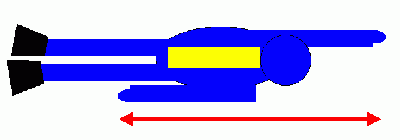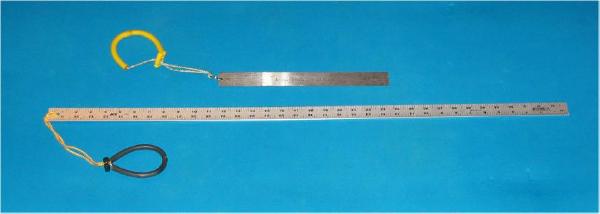
Navigation: Measuring Underwater Distance
by
Larry "Harris" Taylor, Ph.D.
This
material is copyrighted and all rights retained by the author. This article is
made available as a service to the diving community by the author and may be
distributed for any non-commercial or Not-For-Profit use.
All
rights reserved.
Go To: Home About "Harris" Articles Slides War Stories Editorials Links Fini
There are a variety of inexpensive (and not so inexpensive) electronic devices for measuring position and distance with great reliability, accuracy and precision while on the surface. Unfortunately, most of these devices do not function in the underwater world. Sometimes, it is necessary or convenient to measure distances underwater. While acoustic devices are becoming available to the recreational diver, they seldom have a resolution of less than the nearest foot. This article will focus on inexpensive devices that recreational divers can use for more precise measurements.
Body Dimensions
While typically not rigorously reliable, various body dimensions can be used underwater for crude estimates of distance. The most common involves the thumb ( from first knuckle to tip; approximately 1 inch), out-stretched hand (6-10 inches), out-stretched arms (tip-to-tip approximately body height ). A common technique for estimating distance involves using the outstretched arms while moving along a path (as shown below). Obviously, any reliance on body measurements is an individual matter and requires measurement of the body against a known distance.

Kick Cycles
This is a common technique for measuring distance while swimming. A kick-cycle is counted every time the diver kicks with one particular leg (i.e. half the total number of kicks). This is determined by measuring the time and number of kicks-cycles it takes to swim a measured course. We typically use a 100 foot line and average time, counted kicks, and air pressure readings for three determinations. This is usually done as a buddy team with one diver counting kicks and recording air pressure readings, while the other determines time.
For example, assume a diver averages 1.5 minutes to swim 100 feet. This corresponds to: (remember we want velocity which is distance divided by time):.
100 ft / 1.5 min = 66.57 ft / min
This diver also counted 25 (taken for ease of calculation) kick cycles for the 100 ft. course. This corresponds to a distance per kick of
100 ft / 25 kicks = 4 ft. per kick cycle
So, in this hypothetical situation, if the diver needed to swim 600 feet to an underwater object, the diver would reach the object (assuming swimming in a straight line and no current influences):
600 ft / 4 ft/kick cycle = 150 kick cycles
The 150 kick cycles would take (assuming constant speed)
150 kick cycles x 4 ft/kick cycle x 1/66.6 ft/min = 9 minutes
Kick cycles combined with Estimating Air Consumption represent a reasonable method for approximating dive parameters and making decisions on the dive site feasibility, especially when working from a nautical chart.
Rulers
For short distances, divers often carry rulers or yard (meter) sticks. Metal devices are more durable than wood or plastic. Many of these are pre-drilled with a small hole. The hole makes a convenient place for attachment of a lanyard or snap.

Underwater lasers can be added to rulers see below) to give a device for measuring distance from afar (depending on ambient light and water clarity). This device is described separately at yardstick.

Surveyor's Tape
These are fiberglass tapes on a convenient reel. They offer superb, relatively low cost tools for measuring distances on the surface and underwater. They are commonly available in 100 and 200 feet lengths. Most have English units on one side and metric on the other. I add two polypropylene (nylon absorbs water, gets brittle and breaks) tie-wraps around the handle as a place to attach clips to secure the tape and a wrist lanyard to facilitate handling during entry, non-use and exit. (Remember that a primary rule on mission-oriented diving is to exit post-dive with the same amount (or more) of equipment as you entered.)

Diver's Reels
These line-holders are typically sold at dive shops for divers to use towing floats. They typically hold 100 feet of 1/4" nylon line. They can also be used as crude measuring devices when the line is used as a baseline for underwater operations. In addition, when towing a float or using the line in a circular sweep search operation, the markings on the line can give an estimate of the amount of line deployed. The reel on the left has the advantage that it can be mounted ion the wrist and does not require use of a hand to hold onto the reel during use, We use a permanent ink pen to mark our lines every foot (using a surveyors tape as a reference). We use increasing length marks for 1, 5, 10 and 50 foot increments as shown below right. The example, at the very bottom right, shows the markings for 77 feet.


Cloth Tape
Divers have employed a variety of tools (metal rulers, yard sticks, and carpenter's squares) and implements for measuring short distances, especially when documenting artifacts and structures surrounding wrecks. However, tools designed for the surface are often cumbersome to use and carry underwater and/or readily corrode. Fiberglass tapes (commonly found in sewing, quilting or crafts retailers) used for measuring cloth or apparel have ideal in-water characteristics, but a totally unrolled 6 foot or 10 foot tape can be awkward at depth. We use a small reel for these tapes and small lines. The construction of this tape reel starts with a mini-blind cleaner, below left. Begin by removing the cleaning rolls, below right.


Next, break off the internal rungs. The small bumps of plastic remaining on the handle can be filed to smoothness. However, this is typically not necessary.

The 6 or 10 foot fiberglass tape is prepared by gluing (aquarium silicone sealant or Velcro glue), followed by sewing a small Velcro patch on one end of the tape. (Remember to let the glue totally dry before sewing; failure to do can severely damage a sewing machine) After stitching. use a SMALL amount of glue on the stitches to add to their strength. Be careful to limit the area of the glue coverage because any Velcro spot with glue on it will not stick to its mate. The combination of glue and sewing provides strength for holding the tape in place. The highest measurement end is the end secured to the reel as measurements begin with the zero point ... the tape is only unrolled to the distance needed for measurement.

The Velcro secures the tape to one end of the mini-blind cleaner-turned-into-small-hand-reel. The tape is then wrapped around the reel.

Next, 1.5 " washers are added as a tape retainer. I took the above assembly to a hardware store to make certain that the purchased hardware would fit the device.

The washers are held in place by Size 006 Wire Guard Wire Connectors. (These are commonly used as protectors of electrical contacts made by twisting wires together.). First cut the handle pegs just inside of the plastic bulge to provide the appropriate distance for the connector. This may take some trial and error and some patience to get the connector started.

Next, drill a 9/64" hole in the handle. Threading a twist or cable wrap through this hole provides a means for securing the end of the measuring tape when not being used for measurements. A bit of silicone aquarium cement holds the twist in place.

Finally, add a lanyard or other attachment to facilitate possession when not in direct use.

The "mini-blind" reel is now ready to use. This reel can also be used for small lengths of line. A size comparison of common diver line reels is shown below.

Conclusion
For those times when it is necessary to establish distance underwater, the diver has several options. The choice of tool used will depend upon the individual needs of the diver. A fiberglass tape used in sewing and crafts can be turned into a useful underwater measuring tool.
Go To: Home About "Harris" Articles Slides War Stories Editorials Links Fini
About
The Author:
Larry "Harris" Taylor, Ph.D. is a biochemist and Diving Safety Coordinator at the University of Michigan. He has authored more than 200 scuba related articles. His personal dive library (See Alert Diver, Mar/Apr, 1997, p. 54) is considered one of the best recreational sources of information In North America.
All rights reserved
Use of these articles for personal or organizational profit is specifically denied.
These articles may be used for not-for-profit diving education